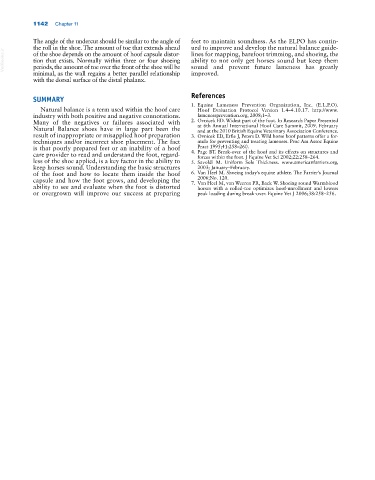Page 1176 - Adams and Stashak's Lameness in Horses, 7th Edition
P. 1176
1142 Chapter 11
The angle of the undercut should be similar to the angle of feet to maintain soundness. As the ELPO has contin
the roll in the shoe. The amount of toe that extends ahead ued to improve and develop the natural balance guide
VetBooks.ir tion that exists. Normally within three or four shoeing ability to not only get horses sound but keep them
lines for mapping, barefoot trimming, and shoeing, the
of the shoe depends on the amount of hoof capsule distor
sound and prevent future lameness has greatly
periods, the amount of toe over the front of the shoe will be
minimal, as the wall regains a better parallel relationship improved.
with the dorsal surface of the distal phalanx.
SUMMARY References
1. Equine Lameness Prevention Organization, Inc. (E.L.P.O).
Natural balance is a term used within the hoof care Hoof Evaluation Protocol Version 1.4–4.10.17. http://www.
industry with both positive and negative connotations. lamenessprevention.org, 2008;1–3.
Many of the negatives or failures associated with 2. Ovnicek ED. Widest part of the foot. In Research Paper Presented
Natural Balance shoes have in large part been the at 6th Annual International Hoof Care Summit, 2009. February
and at the 2010 British Equine Veterinary Association Conference.
result of inappropriate or misapplied hoof preparation 3. Ovnicek ED, Erfle J, Peters D. Wild horse hoof patterns offer a for
techniques and/or incorrect shoe placement. The fact mula for preventing and treating lameness. Proc Am Assoc Equine
is that poorly prepared feet or an inability of a hoof Pract 1995;41:258–260.
care provider to read and understand the foot, regard 4. Page BT. Break‐over of the hoof and its effects on structures and
forces within the foot. J Equine Vet Sci 2002;22:258–264.
less of the shoe applied, is a key factor in the ability to 5. Savoldi M. Uniform Sole Thickness. www.americanfarriers.org,
keep horses sound. Understanding the basic structures 2003; January–February.
of the foot and how to locate them inside the hoof 6. Van Heel M. Shoeing today’s equine athlete. The Farrier’s Journal
2006;No. 120.
capsule and how the foot grows, and developing the 7. Van Heel M, van Weeren PR, Back W. Shoeing sound Warmblood
ability to see and evaluate when the foot is distorted horses with a rolled‐toe optimizes hoof‐unrollment and lowers
or overgrown will improve our success at preparing peak loading during break‐over. Equine Vet J 2006;38:258–256.

